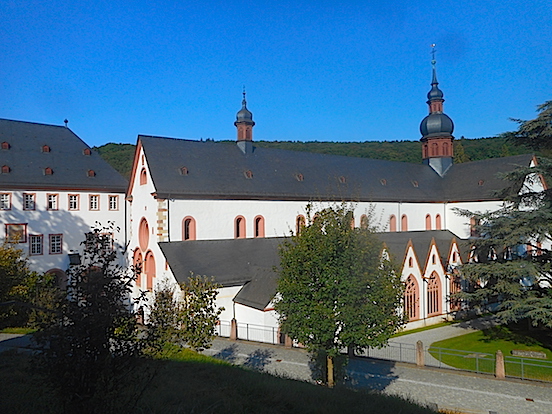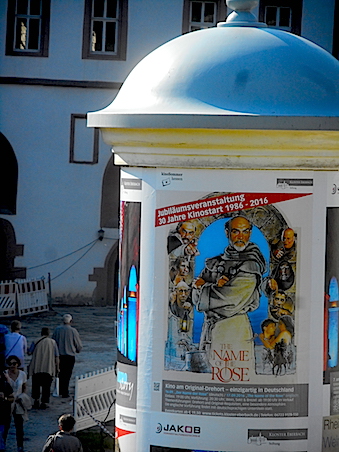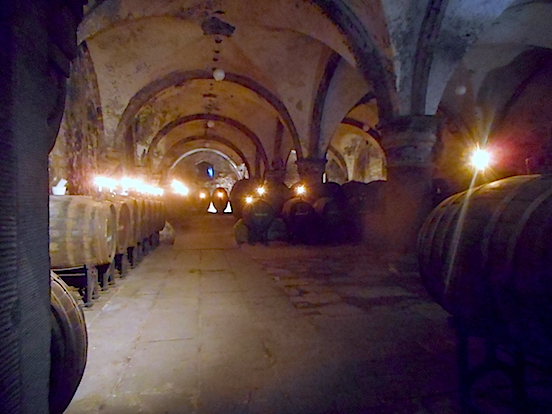Search
Recent comments
- US gangsters....
42 min 32 sec ago - intel failure....
2 hours 13 min ago - stealing oil...
5 hours 41 min ago - warmongers....
9 hours 4 min ago - stop lammy's murders....
9 hours 25 min ago - a piss president....
9 hours 32 min ago - not gone?.....
12 hours 3 min ago - stoopid kakka....
12 hours 48 min ago - last offer....
13 hours 19 min ago - overstaying.....
15 hours 21 min ago
Democracy Links
Member's Off-site Blogs
god's empty nests...
 refectory
refectory
The tables have gone. The refectory is empty. It's a beautiful empty nest of god... now visited by dilettante tourists on a schedule and cinematographers...
The clanging of dishes echoes through the refectory, the abbey's dining area. Monks sit at long wooden tables, silently spooning up their bouillon-and-pancake soup. There is entertainment on offer for the evening meal: One of their fellow monks is reading aloud a book about the first Christians in antique Rome. Back then, they were a sect that lived in small communities, on the edge of society.
The walls of the dimly lit refectory are decorated with painted Bible scenes. The floor is adorned with mosaics. Most of the tables in the space, which is as big as a gymnasium, are unoccupied. In the monks' neighboring living quarters, the so-called cloister, entire floors are deserted. Many rooms are empty or used as storage spaces. In many cases, their inhabitants died long ago.
…German society is moving away from spirituality, from religion, and especially from the church. This development is felt particularly strongly among religious orders. They are dying out. Everywhere, monasteries and convents are disappearing.
The German Conference of Superiors of Religious Orders (DOK), an association of Catholic congregations, has adopted a novel strategy to try and keep live-in religious communities from dying out: As of recently, women and men of any age can "live, pray, work and learn" in a monastery for three to 12 months as part of a "voluntary year," as its home page says.
The participants don't commit to anything. "One can leave at any time," says Sister Maria Stadler, who organizes the program. She says it is all about making people more familiar with monastic life and all its spiritual aspects. "The day is permeated with prayer. This can provide stability," says the nun. But there are risks, she adds. Applicants should have a "certain psychological stability." Far from all activity, she says, one becomes very introspective. There is a lot of time to think. Too much time?
https://www.spiegel.de/international/germany/vanishing-monasteries-in-ge...
—————————————
Some monasteries invite tourists for lunch (35 Euros set menu or a la carte — excellent local pinot gris) and/or become movie sets. The monastery near Wiesbaden, pictured (Gus Leonisky) above was used for "The Name of the Rose”. The dwindling monks still make their own wines, beers and supply fantastic setting for weddings. Imagine getting married with 40 guests in a 14th century old massive church that used to hold more than a 1000 praying monks, while a recording plays “your” favourite song, "Stairway to Heaven” in a pop music rendition. The echo will stay in your ears forever-after.

The Name of the Rose (Italian: Il nome della rosa [il ˈnoːme della ˈrɔːza]) is the 1980 debut novel by Italian author Umberto Eco. It is a historical murder mystery set in an Italian monastery in the year 1327; an intellectual mystery combining semiotics in fiction, biblical analysis, medieval studies, and literary theory. It was translated into English by William Weaver in 1983.
The novel has sold over 50 million copies worldwide, becoming one of the best-selling books ever published.[1] It has received many international awards and accolades, such as the Strega Prize in 1981 and Prix Medicis Étrangère in 1982, and was ranked 14th on Le Monde's 100 Books of the Century list.
https://en.wikipedia.org/wiki/The_Name_of_the_Rose

The Name of the Rose movie was mostly shot in this monastery... ---------------------- Becoming introspective in such environment tends to make people believe in god or become depressed — or lead to murder. Better become a student of the nature around, than fester with philosophy inside closed walls — unless they are those of the IMMENSE CELLARS....
 Pictures by Gus Leonisky.
Pictures by Gus Leonisky. - By Gus Leonisky at 21 Sep 2019 - 9:18am
- Gus Leonisky's blog
- Login or register to post comments
хорошие дружелюбные люди...
Aelita Prize
The motto of the whole exhibition, the words of Isaac Asimov” … All those I met thanks to my work in science fiction, were wonderfully nice, friendly people.”
The Russians award the “Aelita Prize” for science fiction, we have “comicons”. We don’t seem to take dystopia seriously, unless we take it as a serious social option.
Isaac Asimov (/ˈæzɪmɒv/;[b][c] c. January 2, 1920[a] – April 6, 1992) was an American writer and professor of biochemistry at Boston University. He was known for his works of science fiction and popular science. Asimov was a prolific writer who wrote or edited more than 500 books and an estimated 90,000 letters and postcards.[d]His books have been published in 9 of the 10 major categories of the Dewey Decimal Classification.[1]
Asimov wrote hard science fiction. Along with Robert A. Heinlein and Arthur C. Clarke, Asimov was considered one of the "Big Three" science fiction writers during his lifetime.[2] Asimov's most famous work is the "Foundation" series,[3] the first three books of which won the one-time Hugo Award for "Best All-Time Series" in 1966.[4] His other major series are the "Galactic Empire" series and the Robot series. The Galactic Empire novels are set in earlier history of the same fictional universe as the Foundation series. Later, with Foundation and Earth(1986), he linked this distant future to the Robot stories, creating a unified "future history" for his stories much like those pioneered by Robert A. Heinlein and previously produced by Cordwainer Smith and Poul Anderson.[5] He also wrote hundreds of short stories, including the social science fiction novelette "Nightfall", which in 1964 was voted the best short science fiction story of all time by the Science Fiction Writers of America. Asimov wrote the Lucky Starr series of juvenile science-fiction novels using the pen name Paul French.[6]
Asimov also wrote mysteries and fantasy, as well as much nonfiction. Most of his popular science books explain concepts in a historical way, going as far back as possible to a time when the science in question was at its simplest stage. Examples include Guide to Science, the three-volume set Understanding Physics, and Asimov's Chronology of Science and Discovery. He wrote on numerous other scientific and non-scientific topics, such as chemistry, astronomy, mathematics, history, biblical exegesis, and literary criticism.
He was president of the American Humanist Association.[7] The asteroid 5020 Asimov,[8] a crater on the planet Mars,[9][10] a Brooklyn elementary school,[11]and a literary award are named in his honor.
Read more:
https://en.wikipedia.org/wiki/Isaac_Asimov
Note: Asimov did not speak Russian. He only spoke Yiddish and English...
god's mega-money...
Meanwhile in the USA:
Months after Pastor Victor S. Couzens of Inspirational Baptist Church in Cincinnati, Ohio, pleaded with his congregants to start giving again while assuring them that he had not used their donations to finance relationships with multiple women, his church’s sprawling building is now up for sale.
The church located at 11450 Sebring Drive is currently listed for sale for $8 million on the commercial real estate platform LoopNet.com.
“Perfect for campus/education facility, medical or industrial user and charitable pickup center office - many possibilities. Additional land available for expansion. Currently operating as a church in EXCELLENT condition with many amenities. Large parking lot,” reads the investment summary for the just over 59,000 square-foot building that was built in 1984.
The Christian Post reached out to both Couzens and his church Thursday to discuss what prompted the sale but a response was not immediately available from the church, which celebrated its 62nd anniversary on Sunday.
“We’re celebrating 62 years of this church’s existence, we’re so grateful to the Lord for 62 years of ministry of the Inspirational Church. Let’s praise God for 62 years. Our lives are better because of Inspirational. Our city is better because of Inspirational,” Couzens declared during a broadcast of his church’s worship service on Sunday.
Read more:
https://www.christianpost.com/news/ohio-megachurch-on-sale-for-8m-months...
christ was a communist...
Rod Dreher ponders about politics and Christianity:
...
I wonder if the frustration of the reader above [read article] with the idea of “transformation” in his leftish parish resonates with the frustration of that Evangelical pastor, who could not move his rightish congregation away from their unstated belief that the most important thing about their corporate Christian identity is “we’re not left-wing.”
It’s a hard balance to strike. Nobody is satisfied with pastors who avoid taking hard stands on any issue, out of ( fear ) an abundance of caution over being too political. We all know the types. Years ago, I got into an argument with a pastor who was personally pro-life, but who told me he would never preach about abortion because he believed it was wrong to “divide the congregation.” This rationalization allowed him to avoid preaching anything controversial, ever. Not about abortion, not about racism, not about sex, or greed, or anything that might trouble anybody’s conscience — or, actually, spark anybody’s interest.
Christianity is a faith that has a public dimension. If our faith is only a matter of private devotion, it isn’t Christianity. But the Christian faith also can’t be neatly fit into political categories. I tell you, I am glad that I am not a pastor these days. As I’ve said before, the churches really are suffering from a dearth of good leadership. But they are also suffering from a dearth of good followership.
------------------
Gus:
Christ never acted politics, except about giving back to Caesar what belonged to Caesar. Never made deals about beliefs and treated everyone the same, except the merchants in the temple who desacrated the idea of god. These days temple are run on moneys. Lots of cash. Without the merchants of godly things, the temples would not exist. We could find that Christ never preached against abortion — and even it's not mentioned in the biblical text that were written much later:
--------------------------
Right-wing pseudo-Christians engage in an amazingly selective and distorted view of the Bible. Let's contrast their disparate treatment of two issues: economic justice, and abortion.
Nowhere in either the Old or New Testaments is "abortion" forbidden. All sorts of horrible acts are explicitly condemned and/or proscribed, but not abortion. During the times when both the Old and New Testaments were written, the Jewish community did not forbid abortion. Anti-choice Christians simply make up an entire Biblical justification for their anti-choice position based on the inferences they read into a few Biblical passages.
I don't say here that they're right, and I don't say here they're wrong about abortion. What I do say is, it is strange indeed that right-wing pseudo-Christians expend extraordinary amounts of time and energy to ensure the forbidding of an act not explicitly forbidden in the Bible, yet they spend comparably little time fostering the actions that again and again they are explicitly commanded to undertake: to save the hungry, naked, thirsty, and sick as Matthew 25:31-46 enjoins us, as well as to more generally ensure that the poor are not oppressed, economic justice is established, and immigrants are welcomed and treated well, as the Old Testament repeatedly commands us. This is so even though the Matthew 25 injunctions are matters of life and death to millions, if not tens of millions of already-born, unquestionably human beings every year.
Right-wing pseudo-Christians don't seem to apply to Matthew 25 the same absolutist black/white analysis that they employ in their broad interpretation of "Thou shalt not kill," even though Matthew 25 is explicitly stated in black-and-white terms: the hungry, naked, sick, thirsty, etc – no exceptions -- must be helped, with the gravest of all possible consequences if you do not do so.
Compare the pseudo-Christian right's lackadaisical, let's partly accomplish these economic justice/feed the hungry type goals, not necessarily as our top priority, not necessarily right now, and let's depend for our success on the voluntary efforts of private citizens who almost certainly don't have the resources on their own to really accomplish all of what needs to be done – with their total, immediate, mobilize all resources of both private citizens and the government to 100% stop right now all abortions.
What the Bible doesn't explicitly speak about, they devote unlimited amounts of time and effort to. What the Bible does explicitly command, they relegate to a relative afterthought.
Read more: http://www.right-wing-pseudo-christians.com/jesus-abortion-homosexuality.htm
Meanwhile, the funniest religious news of the day is mercenary:
One Italian priest keen to help parishioners keep the faith has coined a novel idea to encourage them to pray: granting parking spaces in exchange, not for cash, but Hail Marys.The ‘price’ runs from 10 Hail Marys for one hour of parking, right up to a whole novena for five hours.
The parish priest of the Madonna Del Passo in Avezzano, Vincenzo De Mario, said he introduced the parking rate to encourage church-goers to pray, and “for those who do not attend, [this] may be an opportunity to reflect.”
Read more:
https://www.rt.com/news/469345-prayers-for-parking-italy/
I can see the parking signs... and the Hail Mary council police with the penalty machine at hand...
Read from top.
oh for a natural world without a stupid designer...
Professor Richard Dawkins has written a book called Outgrowing God: A Beginner’s Guide. Its aim is to save children and young people from belief in the sky fairy. A couple of weeks ago he was plugging it on Channel 4 News. ‘Facts are so wonderful… and such a treat!’, he trilled, sounding not unlike the late Queen Mother.
Indeed. Which is why a thread that appeared on Twitter on Saturday is so delicious. It was written by George Heath-Whyte, a researcher at Cambridge. It begins: ‘Reading @RichardDawkins new book “Outgrowing God”, and as an Assyriologist I’ve had a couple of major face-palms moments.’
In a chapter called ‘Goodbye God’, Dawkins explains that the Old Testament story of Noah comes from a Babylonian myth, the legend of Utnapishtim, which is turn was taken from the Sumerian Epic of Gilgamesh.
It was this discussion that led Heath-Whyte to cover his face with his palms. Unfortunately for Dawkins, he then removed them and started jabbing out a devastating series of tweets. ‘Where to even start?’, he asked.
‘Well let’s start with “The Utnapishtim story … comes from the Sumerian Epic of Gilgamesh.” WHAT. The version of the Gilgamesh story that contains the flood narrative of Utnapishtim is NOT written in Sumerian, but Babylonian (Akkadian).
‘There are older Sumerian stories about the character Gilgamesh, none of which contain a flood story. There is even a Sumerian flood story too, but it’s not the flood story he’s talking about.
‘It seems he’s talking about a weird mix of one Babylonian flood story about a guy called Atrahasis and another Babylonian flood story about Utnapishtim (the latter being a part of the Babylonian epic of Gilgamesh)…
https://www.spectator.com.au/2019/09/if-richard-dawkins-loves-facts-so-m...
---------------
"Fuck this" I was going to say, but I will moderate my comment to "Most interesting!". The brilliant young "researcher", George Heath-Whyte, at the famous Gligamush Cambolo-Universitarity may or may not know all the facts about Babylon either, though he seems to have read a lot of clay tablets. But thank you THANK YOU, anyway for straightening this ancient history — which was reported by as many liars as there are today — a history which so far may only have been known as Dawkins wrote it... He is a big man and he might revise this suck-on-this-histoire, in further editions
The point made by Dawkins is that (even if his history is not correct about the lingo used — or not used —or the touristic places of interest are not on the map yet), is that THERE HAS BEEN STORIES used in the bible that did not have biblical origins — and that those stories are a bit vague in regard to how say the floods happened, and that eventually the narratives were acquired by the Jews to suit their views of god and humanity. Acquiring pagan rites and gods is often done by the religious mobs, including the popes with Zeus and other deity adorning the Sistine Chapel and fitting the birth of Christ on Santa Claus' Day. Trying to fit scientific rigour into religious fairy tales is another present trick of the bigoted mobs.
The Aboriginal people of Australia's "Arnhem Land" (Yolngu people) recorded the "flooding" between 14,000 and 10,000 years ago in rock paintings. This of course MATCHES the big melt at the end of the last ice age. The paintings have been thus carbon-dated.
The end of this ice age is controversial in regard to our present anthropogenic global warming which is piggybacking on a warm period, while the end of the ice age was partially natural and partially induced by burning forests as attested by ashes in the ice record. Many anthropologist associate the burning of the forest has being deliberately lit — associated with human expansion, as the ice retreated.
But good for Dawkins to push for a better understanding of the world and pox on the Spectator which is a gutter rag of the ignorant political rightwing and religious idiots that has had for editors Nigel Lawson and Boris Johnson, both idiots on the question of global warming.
In regard to Babylon fuzzy history read also: http://www.yourdemocracy.net.au/drupal/node/969
Read from top.